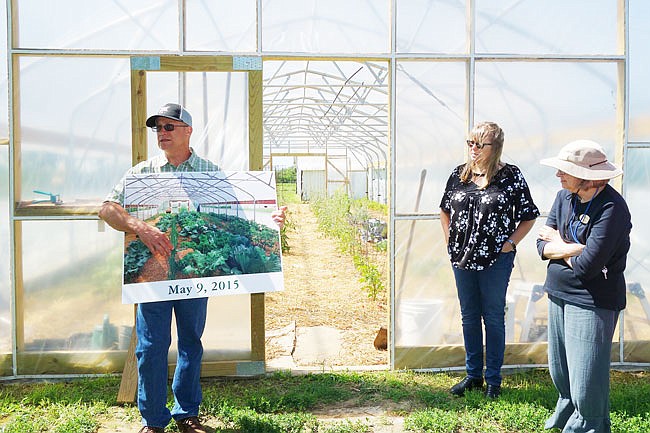Fulton Garden Club members went on a whirlwind tour of some of the town's finest gardens Thursday.
In addition to Karin and Glen Franzen's shady oasis (see "The Franzen's special garden"), stops included Patti Jo Peevy's whimsical gardens, Cathy Woodson's country retreat and Peter Sutter's experimental plots.
Peevy
Patti Jo Peevy welcomed the touring garden club members wearing a matching floral track suit and holding a tiny Yorkshire terrier named Sophia Lauren.
Her gardens match perfectly with her abundant personality. She and husband Jim have spent 17 years developing what was once a pasture into a lovely property.
"A lot of our gardens have names," she said. "I'm eccentric that way."
Scattered across several garden beds are a larger-than-life tortoise statue (named Menardo), four burbling fountains and a large winged pig statue. Everything has a story.
Jim is responsible for the flying pig. He spotted it while on a fishing trip in Arkansas with family.
"I thought it'd be a nice anniversary gift," he said. "So I loaded it in the truck and brought it home. She didn't see it that way."
"Usually, he buys me jewelry for anniversaries," Patti Jo said.
"She named it Sapphire and it's been here ever since," Jim added.
Many plants in the Peevys' gardens were gifts from family, neighbors and friends. One plot is designated the memorial garden, in honor of family members who've passed away.
The Peevys garden with love.
"I get out here and set and just talk to (the plants)," Patti Jo said. "Jim leaves the radio running for the plants in the greenhouse. It makes them happy."
Garden club members also noted Patti Jo's lush "red hot poker" plants and lavender. Her secret?
"I'm a big believer in Miracle Gro," she said.
Woodson
The 80-acre farm on Mokane Road has been in Cathy Woodson's family for generations.
"My great-grandma owned it back in the '50s, then my grandmother did," she said. "I grew up playing in the outbuildings and barns."
After her father passed away, it fell to Woodson and her siblings to care for the property.
"I had a hard time at first, getting into the outdoor life," she said. "I've been an office worker, and I didn't like bugs. I love it now."
No one actually lives in the two-story white farmhouse - instead, it's maintained as a place for family get-togethers. Woodson and her husband live in Fulton but frequently spend full days out on the farm, caring for their horses and cattle.
The push to turn a working farm into a garden worthy of a magazine spread came six years ago, when Woodson's daughter informed her mother she wanted to get married on the family farm.
"It turned into a big project," Woodson said.
She and her husband planned to plant annuals all along the fence row leading back into the property. They were in for a series of unpleasant surprises once they started plowing: People had burned trash in a number of spots; the ground was soggy in some places and bone-dry in others; and there was hardly any dirt, just good ol' Missouri clay.
Woodson planted by trial and error, finding out what thrives where over time.
"You're seeing what lives here, not the thousands of plants that ended up in the trash," she said. "I didn't expect this to take six years to grow."
After her daughter's wedding, Woodson swore to herself she'd never go through such an ordeal again.
"This year, my niece is getting married here," she said with a laugh.
Sutter
Master Gardener Peter Sutter is gardening through adversity this year.
Sutter's gardening season began on a high note. He'd constructed a brand-new, movable high tunnel greenhouse.
"I had a greenhouse previously, but because the climate inside is static, disease builds up over time," he said. "I was having to plant tomatoes that are resistant to just about everything."
The new design can be moved in any direction, and its sides roll up for ventilation. Once troubling diseases pop up, all Sutter has to do is move it over and establish a new plot while the sun and fresh air cleanse the old one.
But a gardener's best-laid plans can be foiled by bad soil.
"We brought the soil out in October," he said. "Turns out, it came from a field that had been treated with a broad-leaf herbicide. It's killing everything in there."
Normally, the early heat and humidity provided by his greenhouse creates a veritable vegetable jungle by this time of the year. Now, his tomatoes are tiny, desperately shooting out fruit before they die. His peas are withered. His cabbage can't produce a head.
"With the herbicide, I wouldn't eat it even if I did get a crop," he said.
After talking to the University of Missouri Extension, Sutter has a plan to make the soil usable - but it'll take two years. He said gardening friends have reported similar problems caused by manure.
"The pesticides will just go right through the horse or cow, come out and kill your garden," he said.
That's why he's focusing on what he calls the "Sutter Experimental Farm." It's a large garden plot, half planted with your usual garden favorites and half with sun hemp, a tropical plant that fixes massive amounts of nitrogen in the soil.
"It can fix 150-170 pounds per acre, which is normally what you put on farmland," Sutter said.
In late fall, he'll till that under and plant rye, which will become a kind of green manure in spring.
"I'm trying to get it so I don't have to bring anything in," he said.

